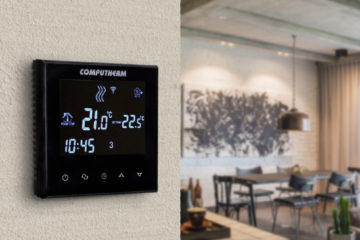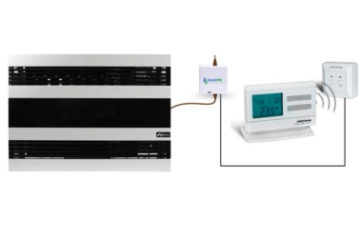Gas heaters with flue gas discharge to the outside are often called gas convectors. This is why convectors transfer most of their heat to a room through a physical phenomenon called convection.
How do gas convectors discharge exhaust fumes to the outside?
Gas convectors have a steel enameled or cast-iron combustion chamber with a stainless steel or ceramic burner, in the case of models with a programmable thermostat from the Piecyki Gazowe Sp z oo company. A turbo chimney, i.e. a pipe in a pipe, is connected to the combustion chamber. Air for gas combustion is supplied through the outer pipe. The flue gas is thrown outside the room through an internal, smaller diameter pipe. Turbo heaters, i.e. heaters with a double pipe, do not take combustion air from the inside. Gas heaters from Gas Stoves have three types of control.

Gas heaters with mechanical thermostatic valve SIT.
Gas heaters with exhaust gas discharge are regulated by a gas valve with a mechanical thermostat in the temperature range 13-35 C. How does a valve with a mechanical thermostat work? The thermostat is connected by a copper tube to a copper probe containing an expanding liquid connected to the thermostat by a capillary. Each gas convector contains a copper tube that senses the temperature in the room and thus regulates the operation of the gas burner. The gas convector heats up very quickly and heats the room efficiently.
Gas heaters with a mechanical thermostatic valve SIT and a KonvekPro controller with a digital thermostat .
They can be adjusted between 5 and 35 C. The programmable digital thermostat from Computherm with the KonvekPro controller can control the operation of the gas convector. We program the convector working hours and temperature on the thermostat. The KonvekPro controller system and the programmable thermostat can be purchased together with a previously purchased gas heater. When using the KonvekPro controller and the Q7 programmable thermostat, we avoid entering a cold room. For example, when heating the office to save gas, the thermostat in the office will turn off the heater at the end of work, for example at 4:00 p.m. After 4:00 p.m. it will maintain the temperature of 5C. The next day, the thermostat will turn on our gas heater one hour before starting work and heat the room temperature to 20 C.In this way, we obtain greater convenience of using the gas heater and gas savings from 20 to 40%. We can connect a Wi-Fi thermostat to the KonvekPro controller, and this means the ability to control the gas heater via the Internet from a computer or smartphone using the application.

Gas heaters with a programmable digital thermostat and a valve on a 3V battery.
These heaters have a built-in programmable thermostat with a weekly program that turns on the gas heater at certain hours of the day and maintains the set temperatures. Thanks to this, we can control the gas heater in a programmable manner, which means large gas savings. The gas valve is powered by a 230V mains adapter, which changes the voltage to 3V DC. The 230 V power supply can be disconnected and powered by AA 1.5 V, 2 x 1.5 V batteries. The current consumption of the valve during its operation is 1 milliampere per hour. This means that the gas heater can be powered from two AA batteries. Assuming that their capacity is 1000 milli amperes (e.g. a good battery from brand manufacturers), this means that the stove’s valve works without replacing the AA batteries throughout the heating season. This heater can be used there,where there is no electricity, in all kinds of holiday homes, apartments where there is a fear of power failure. The gas convector thermostat is powered by 2 AAA batteries. Thanks to this, we have a guarantee that in places where there may be a shortage of electricity, our heater will work continuously. This is a great way to heat old houses where there was only a coal or wood boiler until now.



